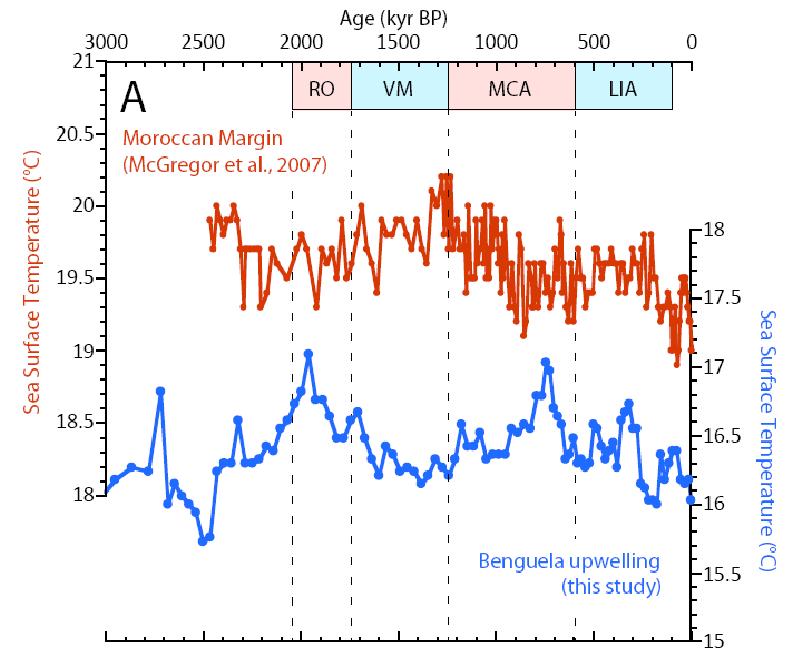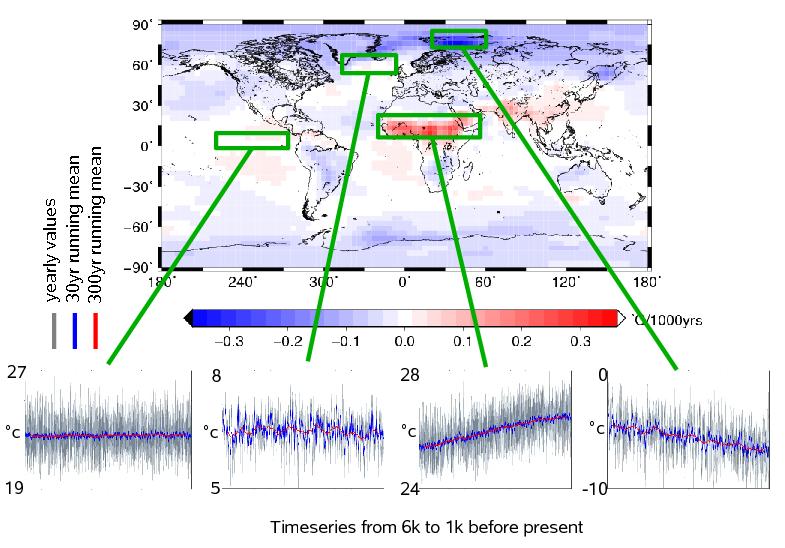|
Evaluation of Eemian and Holocene Climate Variability: Synthesis of marine archives with climate modelling
Principal Investigators: Gerrit Lohmann (AWI Bremerhaven), Ralph Schneider (University of Kiel), Johann Jungclaus (MPI Hamburg)
Project Scientists: Nils Fischer (MPI Hamburg), Guillaume Leduc (University of Kiel), Madlene Pfeiffer (AWI Bremerhaven)
The HoloEem project intends to explore the climate evolution of the Holocene and Eemian interglacials. Our perspective consists in three approaches: 1) A global synthesis of existing, reedited, and newly collected marine proxy data, 2) a state-of-the-art general circulation model used in the assessment of future climate change and 3) a statistical evaluation of regional differences in climatic patterns observed in data records and model results.
The first phase of the project was mainly focused on the Holocene period and provides a baseline for ongoing studies of the Eemian and the last 3 ka that we aim to develop over the 2nd HoloEem phase. Both data reconstruction of sea surface temperature (SST) and modelling experiments investigate the patterns of climate changes regionally. Statistical analysis of spatio-temporal variability in the paleo-data records and in the model results will enable understanding the Holocene climatic changes as reconstructed from proxy data and simulated in model experiments. Control and forced model runs will help to separate internal from externally forced climate variability. The simulations for Holocene and Eemian time slices forced by changes in the Earth's orbit (Figure 1a) as well as the database for Holocene SST as estimated by two proxies (namely Mg/Ca and alkenones, Figure 1b) have been recently published (Leduc et al., 2010; Fischer and Jungclaus, 2010).
The model simulation has evidenced pronounced regional heterogeneity in climate trends attributed to changes in sea ice cover, oceanic heat transport and atmospheric circulation. The most important difference between the Holocene and the Eemian is an enhanced influence of the seasonal cycle of insolation due to a much larger eccentricity during the Eemian (4% versus less than 1.9% in the Holocene). In parallel, the database reveals latitudinally homogeneous Holocene SST trends as estimated with alkenones (and to a lesser extent Mg/Ca), but the two SST proxies bear contrasted SST trends. Since SST alkenone records seem to follow the evolution of contrasted insolation within different latitudinal bands, it is likely that phytoplankton ecology would have had a strong impact on the SST records, and hence may have been impacted by seasonality on a global scale. This latter result was tested by comparing the magnitude of SST changes for both the Holocene and the Eemian periods (i.e. when the magnitudes of seasonal insolation changes were not the same), and is consistent with the finding of Fischer and Jungclaus, 2010 that report qualitatively similar climate trends but larger magnitudes of changes for the Eemian because of increased seasonality. Another interesting observation is the mismatch of the magnitude of SST trend as estimated from proxy data and simulated by transient model experiments for the last 6 ka using ECHO-G (Pfeiffer et al., 2010). This result implies that proxy data overestimate SST changes and/or that models underestimate SST variability. Importantly, a direct comparison of the proxy-based SST trends with the whole set of model experiments performed within the PMIP2 framework and using the 6 ka and pre-industrial time slices indicates that this observation is a very robust feature of model/data comparison of Holocene SST trends (Figure 1c).
Figure 2: SST record from the Benguela upwelling system (blue curve) as compared to Moroccan SST record (red curve, McGregor et al., 2007). Leduc et al., submitted.
We now continue our efforts by establishing a library of high resolution SST data sets covering the last 3,000 years, including new SST records from marine sediment cores covering this time period. One such new record is from the Benguela upwelling system that revealed multi-centennial SST changes over the last 3,000 years, which are found to be in antiphase with a SST record from the Moroccan upwelling system (Figure 2). These changes can be ultimately compared to the ones from the northern North Atlantic Ocean where step-like changes in temperature associated with the transition from the Medieval Climate Anomaly to the Little Ice Age and probably triggered by sudden changes in the Polar Front at this location (Sicre et al., 2008). Interestingly, both northern and southern upwelling systems have accelerated over the last decades, indicating that the natural and anthropogenic climate forcings are acting in quite different manners on the eastern boundary upwelling systems (Leduc et al., submitted).
Figure 3: Sea surface temperature trends in °C/1000 years (upper) and time series from selected locations (lower) from the transient simulation 6kyr BP to 1kyr BP.
That observation will be compared to new transient Holocene simulations (Figure 3), forced with changing orbital conditions only, as well as with experiments using additional external forcing variations. These variations are volcanic eruptions (Crowley, 2000; Crowley, pers. comm.), solar variations (Solanki et al., 2004; Krivova, pers. comm.), and greenhouse gas concentrations for the last 2000 years. These results will be useful to understand the linkage between the northern and southern tropical variability of the Atlantic Ocean. We will provide the first transient ESM simulation from the mid-Holocene to now that provides initial conditions including its millennium scale memory to a forced run over the last 2000 years which then provides initial condition for future climate projections. In this regard, the series of experiments will be completed by climate change projection runs for another 200 years into the future prescribing the greenhouse gas evolution following the Special Report on Emission Scenarios (SRES 2000) as used in the IPCC AR4 experiments. Comparing the simulations with solely orbital forcing with those including modulations of solar activity and volcanic eruptions will provide a diagnostic for the relative roles of external forcing factors and internal variability as well as variability changes under natural and anthropogenic forcing, respectively. Such analysis will be performed in a joint effort using the expertise in paleoclimate data, data analysis, and modelling. In parallel, another idealized transient run for the late Holocene (i.e. the last 6 ka) forced with the Earth's orbit will help disentangling the seasonal signal likely embedded in SST proxies (Pfeiffer et al., 2010).
A first sensitivity study of the Eemian climate with reduced Greenland ice sheet was also performed, indicating quite substantial changes at high latitudes. We will examine the simulations to determine in what epochs the forced simulations show significant trends, and if various indices (AO, NAO, ENSO, Monsoon) and other statistically relevant modes of climate variability differ from or agree with data time series and model results.
Methods Text
Archives
Text
References Crowley, J.T., 2000: Causes of climate change over the last 1000 years. Science, 289, 270-277. Fischer N. and J.H. Jungclaus, 2010: Effects of orbital forcing on atmosphere and ocean heat transports in Holocene and Eemian climate simulations with a comprehensive Earth system model. Clim. Past, 6, 155-168. Leduc G., Schneider R.R., Kim J.-H., and Lohmann G., 2010: Holocene and Eemian sea surface temperature trends as revealed by alkenone and Mg/Ca paleothermometry. Quaternary Science Reviews, 29, 989-1004. Leduc G., C. Herbert, T. Blanz, P. Martinez and R. Schneider, 2010: Contrasting evolution of Sea Surface Temperature in the Benguela upwelling system under natural and anthropogenic climate forcings. Submitted to Geophysical Research Letters. Pfeiffer M., T. Laepple, J.-H. Kim, G. Leduc and G. Lohmann, 2010: A model-data comparison of the Holocene global ocean temperature evolution. Geophysical Research Abstracts 12, EGU2010-11137, EGU General Assembly. Solanki, S.K., I.G. Usoskin, B. Kromer, M. Schüssler, and J. Beer, 2004: Unusual activity of the Sun during recent decades compared to the previous 11,000 years. Nature, 431, 1084-1087. Sicre, M.A., J. Jacob, U. Ezat, S. Rousse, C. Kissel, P. Yiou, J. Eiriksson, K.L. Knudsen, E. Jansen, and J.-L. Turon, 2008: Decadal variability of sea surface temperatures off North Iceland over the last 2000 years, Earth and Planetary Science Letters, 268, 137-142. SRES, 2000: Special Report on Emission Scenarios. A Special Report of IPCC Working Group III. Edited by N. Nakicenovic and R. Swart. Cambridge University Press, Cambridge, UK.
|
| < zurück | weiter > |
|---|




